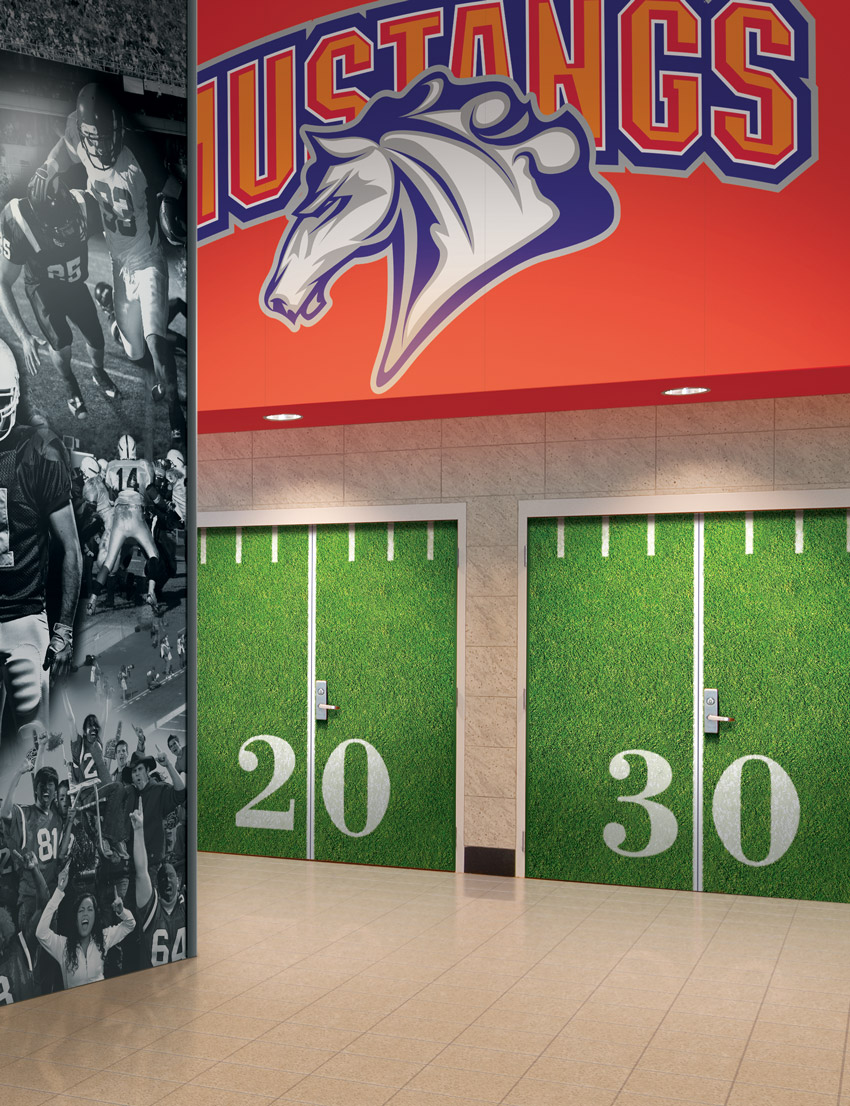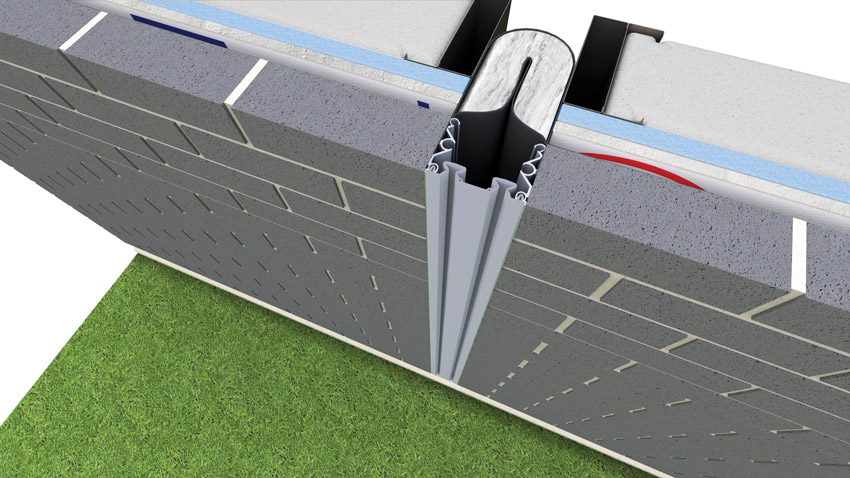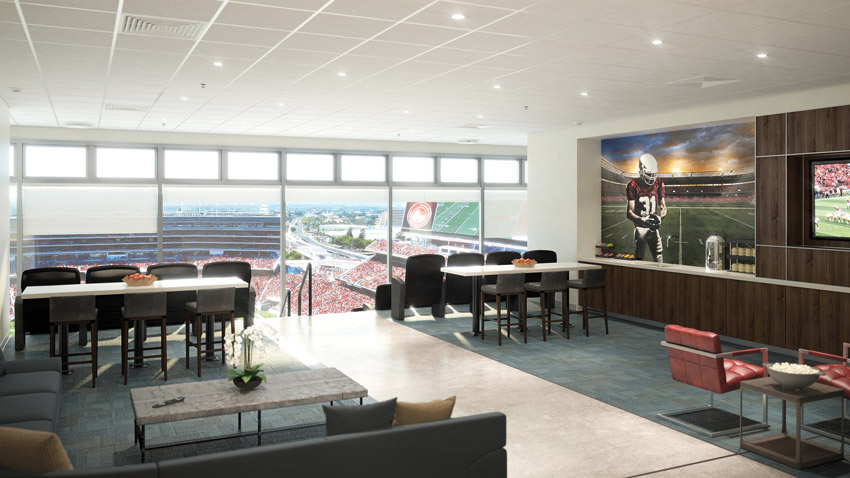Winning Stadium Designs
Opening Glass Walls For Flexibility
As a multiuse facility, stadiums need to accommodate a range of group sizes and a variety of users. Some prefer, and are willing to pay for, gathering in small groups rather than being part of the crowd, and they may be looking for more amenities than open seating can offer. Hence the growth of private or shared boxes with protected or even enclosed spaces and services has become widespread. Similarly, restaurant and bar areas in stadiums seek the same ability to operate smoothly regardless of the weather and be alternately open to the public or closed and secure. The design challenge becomes how to meet these seemingly competing needs as part of the overall stadium design. One proven solution is the use of opening glass walls that can slide or fold completely out of view when open while being able to provide views but resist weather and lock tight when closed.
The flexible operability of opening glass walls enable suites, gathering areas, in-stadiumw restaurants, or bars all to have the ability to configure the space based on the needs of the occupants or the event. For instance, when the glass wall is open, the fans experience the crowd directly, but when closed, the operable glass wall provide a transparent barrier with unobstructed viewing. In cases where the playing field is outdoors, the closed wall also provides greater human comfort with protection from wind, cold air, and noise. Further, when there are no events taking place or in the off-season, the weather-resistant opening glass walls protect interior spaces and furnishings from exposure and/or unauthorized entry.
There are numerous benefits for stadium owners/operator who incorporate opening glass walls and flexible spaces into the design. In many cases, they can command higher ticket prices or permanent seat license (PSL) rates by providing suites that offer a unique experience for the fan, allowing the occupant the choice to open or close the glass panels with ease. Multiple uses and configurations of spaces mean the stadium isn’t limited to an all-or-nothing rental facility. That can mean continuous sources of revenue coming in from various types and sizes of events. By using opening glass walls, separate interior spaces can be created, distinguishing flexible suites from standard luxury boxes and thereby offering a variety of choice and price levels. In the end, it is the spectator/user that benefits from an enhanced experience and more opportunities to find a setting to meet their needs.
From a performance perspective, opening glass walls are available in wood- or aluminum-framed systems or frameless all-glass opening glass systems. The framed systems can be large full-door heights spanning unlimited widths, while the frameless opening glass walls offer an all-glass, no-profile panel for maximum view. Depending on the specifics of the particular system, the openings can range in width from as little as 9 feet wide up to as much as 300 feet or more. They are typically comprised of uniformly sized panels with a top and bottom track along which the doors either fold or slide. With the glass panels open during pleasant weather, they can allow fresh air and connection to the outdoor event area. When the panels are closed, however, they need to create a secure, weather-resistant barrier that protects against rain, snow, humidity, noise, and extreme temperatures. Because of the typically large opening sizes, the corresponding large perimeter area, and multiple joints between panel sections, the ability to seal tightly along all of these locations when closed is important. Therefore, most manufacturers will have their products independently tested to assure that they meet standard criteria for these environmental and security conditions.
From an operational standpoint, the glass panels need to easily glide or fold into position, meaning that the mounting and tracking mechanisms must be proven and reliable. Those can be similarly tested and documented for their performance, but finding a system that is easy to use and fairly intuitive will make it easy for stadium staff or even the general public to operate the panels.
The manufacture and production of operable glass wall systems can certainly vary between suppliers since they require considerable diligence and attention to detail in order achieve high-performance levels. Hence, it is incumbent on specifiers to request independent testing reports on the selected products to determine the results for thermal performance, penetration of wind or water, security, and acoustical characteristics. This stringent and thorough third-party testing ensures optimum performance for specific site conditions. It also means that interior separation of spaces between several smaller groups is effective and does not compromise users in either space.

Photos courtesy of NanaWall Systems
Opening glass walls used in stadiums, such as the Target Center shown here, create flexibility in space usage by functioning in either the closed or open positions, all in a durable and transparent manner.
Protecting Interior Surfaces With Style
All stadium interior spaces that encounter heavy pedestrian and equipment traffic are subject to wall damage. Incorporating wall and corner protection within interior spaces provides more resiliency and time savings for maintenance teams who are challenged with keeping the walls free from scuffs and damage that requires constant attention and repairs. Relying on a maintenance team to address the damage after it occurs can be costly, not to mention disruptive to operations, so it makes sense to look for an alternative in the form of a wall-protection system. These systems are applied to wall substrates and are often manufactured as durable sheet products that come in a variety of thicknesses, most commonly 0.040 inch, 0.060 inch, and 0.075 inch to accommodate different wall conditions and help resist damage from day-to-day use and abuse. Similarly, corner guards can be installed that resist the potential for damage there. Different types are available, including 16 gauge/304 alloy stainless steel sheet for high durability. All of these measures keep the interior of the facility looking as good as it did on opening day, usually for many years down the road. Incorporating resistance to physical abuse reduces the need for maintenance dramatically, making these products a logical choice for designers and building owners alike by eliminating the need for repainting, resurfacing, or repairing unprotected surfaces.
It is worth pointing out that such protection need not be limited just to walls. Rather, doors in a stadium can be selected that have an impact-resistant fabrication and are covered with the same type of sheet products used on walls. This can be particularly helpful in creating durable door solutions for restrooms, janitorial closets, clubhouse entries, and many other high-traffic areas throughout a stadium concourse. The makeup of such doors can meet fire-rating requirements and help extend the service life of the door, making it a very economical solution over the long haul.
Whether used for walls, doors, or both, protective products offer abundant design options and color choices that can create accents or blend into any interior space. A wide range of solid colors, patterns, and simulated wood or metals are available. There are even sought-after options that allow artwork to be installed behind a clear protective sheet and mounted onto a wall or door. Photographs, logos, patterns, or custom artwork can be reverse-printed behind clear rigid sheet, serving as a protective shield for the design while providing impact-resistant protection to the surface below.
Overall, surface protection products offer a highly durable, long-term wall-protection solution that stands up to years of abuse while offering a range of design options appropriate for utility spaces to board rooms and just about everything in between. Renee Hite is the assistant business development manager for Acrovyn by Construction Specialties, and she comments on this type of protective product: “The resiliency, abundant design options and color choices can add style or blend into any interior space, all while offering protection needed in high-traffic interior building spaces.”

Photo courtesy of Construction Specialties
Interior wall surfaces and doors in stadiums can be subject to a lot of use and abuse. Incorporating protective surfacing products over walls and doors can provide the needed durability while offering color and design options as well.
Specialty Products
Stadium design requires attention to detail, and that often translates into the use of specialty products to address some specific needs. Of course those specialties also need to work with the overall design of a stadium.
Expansion Joint Systems
With their sheer size and surface area, stadiums are subject to significant movement of floors, walls and roof areas from thermal or other environmental forces. Therefore, expansion joint systems are a necessary component that must be engineered to handle not only movement but address several other factors too. First is the need for high durability of the joint materials and covers to withstand pedestrian traffic, push carts, scissor lifts, etc. Another factor is the ability to act as a moisture barrier since expansion joints in exterior walls or roofs must prevent rainwater infiltration or help channel rainwater to drainage points. Finally, if the expansion joint is in a fire-rated assembly, then the joint needs to be fire rated as well. Since wet fire barriers can become worthless and dangerous, preventing water from entering a fire barrier is critical to life safety. In that regard, choosing a supplier for expansion joint systems and fire barriers that are truly effective cannot be overstressed.
When looking at expansion joint system selection and specification for stadiums and arenas, several things need to be considered. First is the nominal joint size compared to the range of movement between the minimum fully contracted size and the maximum fully expanded size. The expansion joint system selected needs to accommodate this full movement range. Second is recognizing that building sections can move due to a variety of reasons, including one-directional thermal movement, multidirectional seismic movement, or movement along the joint as in wind-load induced movement. Third is loading requirement, referring to the type of weight and actions that will be induced onto the joint system, including its cover, during building occupancy. Fourth, is continuity of the expansion joints. Since a project scope could include interior and exterior joints or both, the joints need to run continuously through all adjacent planes to fully separate building sections and allow independent movement in things like building veneers, soffits, parking decks, patios, roofing systems, etc. Fifth is attention to fire resistance and moisture control since expansion joints may interrupt building assemblies that need to maintain one or both of these traits while still allowing the appropriate movement to occur. Finally, the form and appearance of expansion joints should be addressed so that it works with the design scheme of the adjacent finishes. With these considerations taken into account, the selection of expansion-joint systems can be worked into specifications and construction drawings to help assure stadiums are properly allowed to move, remain weather and moisture tight, and protect life safety.

Image courtesy of Inpro
Properly designed expansion-joint systems are continuous across all planes of a structure and take into account the differing conditions in different locations.
Large-Scale Graphics
Incorporating standard or customized artwork into a stadium is often desirable for a lot of reasons. These could include creating decorative wall panels, facility branding, storytelling, timelines, lobby displays, informational displays, wayfinding, or as a means to provide a connection with teams or the community. Of course, incorporating such art can be expensive, not to mention easily vandalized or damaged. In order to provide protection but keep the art fully visible, there are systems available that allow art to be printed and combined with a protective covering. The sizes of such protective wall art systems come in a variety of standard sizes and custom sizes are possible too. Mounting options include stand-off style, screwed in place, adhesive, or cabled.
Manufacturers of such systems promote unlimited colors and design options to help create a custom look and fit for any facility. Any image can be used (provided proper reproduction authorization is obtained) and printed in a variety of formats.

Photo courtesy of Inpro
Large-scale graphics can enhance the stadium experience for fans, guests, and patrons by incorporating standard or custom imagery into the interior design of selected spaces.
Notice

www.c-sgroup.com/louvers

www.hormann-flexon.com

www.inprocorp.com/jointmaster-expansion-joint-systems

www.nanawall.com

www.coil.sherwin.com/architect









